Given the nature of the Chronoscape, these animals inhabit both the Chronoscape and in localized sections of Eredia and Shérok. The ones noted here are all sapient in varying degrees and possess a Chronocompass. None of them form telepathic bonds like the elemental dragons do.
Dragon Spirits of Tsotska d’la Mer
These dragons differentiate themselves by retaining some magic. Rather than creating elements, they manipulate the elements around them. In example, they can’t breathe fire unless they start out with some cinders.
Their scales are transparent and reflect the world around them, and this ‘invisibility’ earned them the nickname dragon spirits. When they want to reveal themselves, they ruffle up their scales to jumble the reflections. They are capable of speaking as well as communicating simple images telepathically (although they are incapable of forming bonds this way). They are incredibly flighty and only appear to the Tsotska-mar and individuals who have proven themselves generous through donations to their ‘shrines.’
They range drastically in size, although most are dog-sized and smaller. They appear most similar to Jungle dragons and small amphibious creatures.
Focas
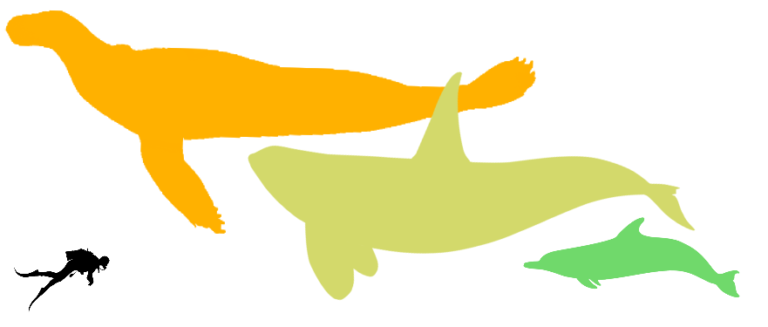
[silhouette stock images from pixabay]
Focas (pronounced foh-kas) are a pinniped species that occupies the oceans of Shérok and Eredia. Their name simply means ‘seal’ in Shéar. Other types of seals are unlikely to inhabit the same areas, but if a distinction needs to be made, these are called elemental seals. They usually occupy the arctic and antarctic areas of the sea, but some elements may drift towards the tropical areas. Unlike many other pinnipeds, they are perfectly at home in the open ocean and do not need land to rest or bear young. Their barrel is especially long to help them use their momentum during hunts. They are known for destroying ships and sea vessels even without the use of magic. They are strictly carnivores and will eat anything from small fish to large whales.
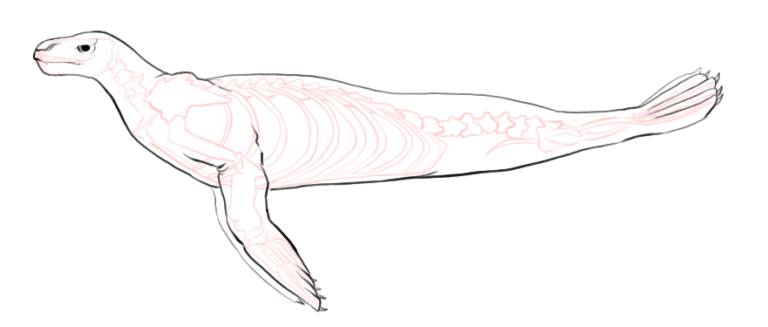
(skeleton referenced from this photo)
While some travel in families, they are unlikely to do so for more than a year. Focas are more typically solitary or travel with a pair bond. Like other creatures with a Chronocompass, they are highly intelligent. They are unlikely to speak more than a few words of ‘human’ language, but are perfectly capable of communicating in the clicks, whistles, and echoes of their own tongue. Their markings include countershading, spots, and freckles of color unless they are using magic. While their magic is active, their eyes glow and tribal markings form across their body. Their traits usually stick to streamlined forms, but some odd mutations are known that affect their dominance or improve their hunting abilities.
They are incredibly important to the culture of northeast Shérok. They are associated with the goddess of death and regarded as her messengers. While their fur is highly valued for both texture and magical properties, only a fool would hunt them.
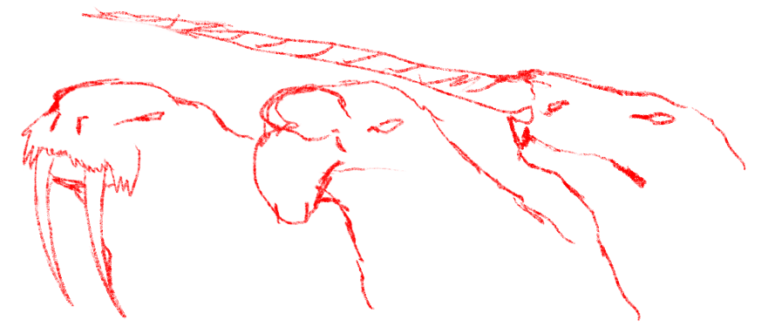
Various types of mutations seen on Focas.
Keo
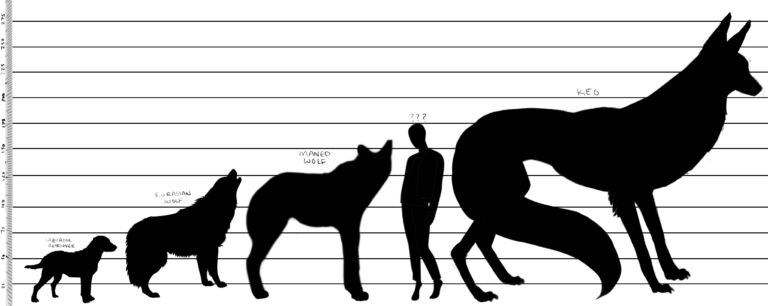
(silhoette stock images from pixabay)
Keo (pronounced kay-oh) are a species of canid that inhabit the cold regions of Shérok and the Chronoscape. Although their territories overlap with Tombre, they fill different niches and can comfortably co-exist. Keo are omnivorous and eat just about any floral they can find. When hunting, they only chase after small prey. They tread on top of snow and try to scare prey out of hiding. When that fails, they use their long legs to pierce through the snow and catch prey from above. They can also burrow comfortably into the snow, their long bodies allowing for ease of movement in large drifts. Thanks to their size, they can even dig through tough snow.
They have defined territories and only wander away when forming a pack of their own. Their homes typically consist of burrows, small caves, and self-built ice structures when the ground cannot be worked. They create interlocked nests with close family members called warrens. Warrens typically house three generations of Keo. They cycle over time, with any great-grandchildren being driven out by the eldest mating pair. Their young are called pups or cubs.
Their thick fur allows them to live in the snow-covered reaches of Inviernot. The same thick fur makes them popular among poachers and fur traders. Compared to other canines, it has a highly elongated spine, tail, and legs–making its head look quite small in comparison to everything else. Their claws are slightly retractable, but not on the level of cats. Females tend to be shorter and stouter to preserve warmth.
They are fully capable of understanding language, although they cannot speak with their vocal chords. Interaction between pack members tends to be silent and they rely mostly on body language. They can squeak, chirp, whine, bark, and growl, but all of these are signs of aggression or fear. Because they hunt prey the size of a cat or smaller, they pose no threat to humans. Their social nature makes them easy to work with, but they are never fully tame. They are capable of using their size to take down threats when no other option is available.
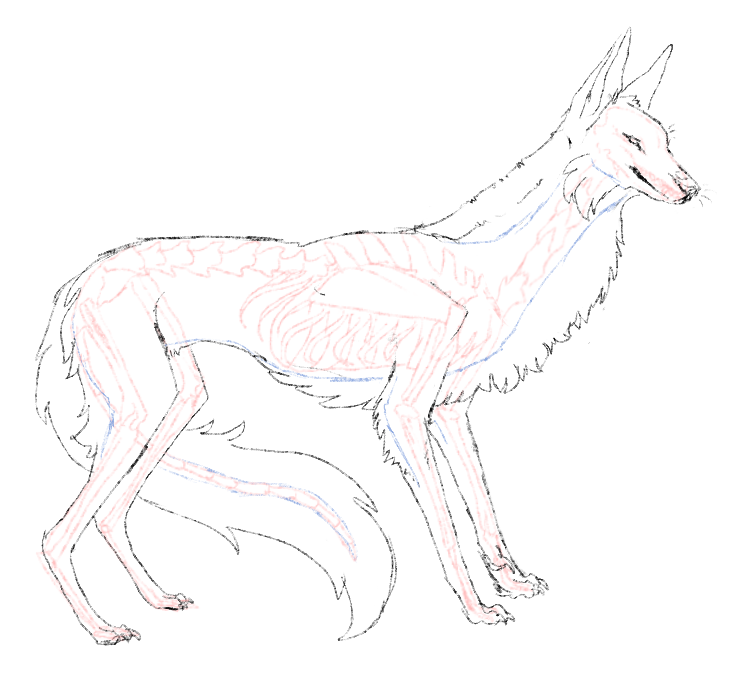
(skeletal anatomy referenced from Pixabay stock images)
More Megafauna:
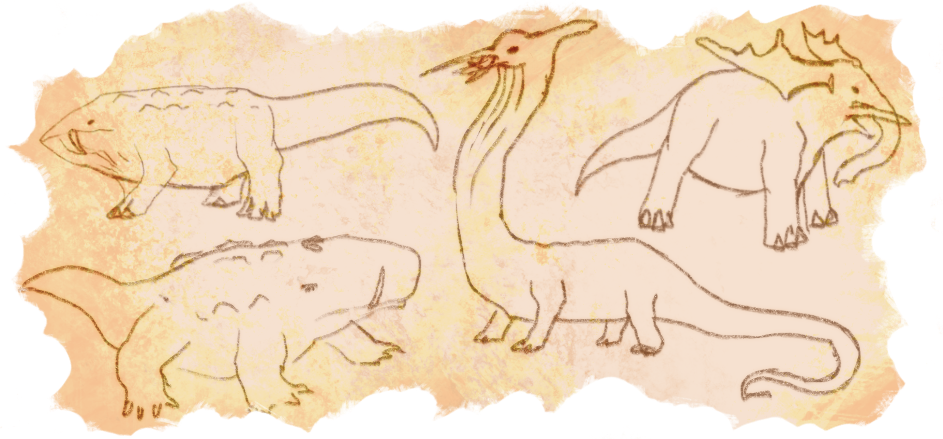
Sirens
Huge, lumbering, slow beasts somewhere in between dragons and whales, and often likened to living mountains. They are separated into flighted and grounded varieties. They are plain in color, often bearing no markings at all. Very little is known about them, as being close to them for short periods of time causes nausea and continued exposure causes permanent illness. If agitated, they use a glowing blue breath that destroys any living creature in its path. They communicate across vast distances via a booming song. Anyone who hears the Siren songs knows to get out of their way before they arrive.
Obsidians
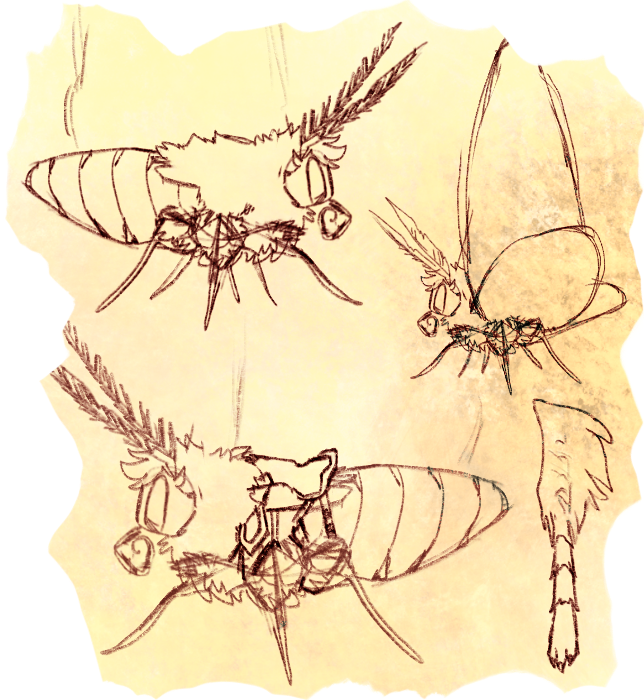
Giant insects resembling members of Lepidoptera. Except, you know, giant. In cold or rainy climates, they will create a silk coat for themselves that resembles fur and fuses to their abdomen. The coat is replaced each time they molt--roughly twice per year. It is highly prized and a common target for hunters. They are exceptionally good at navigating caves, forests, canyons, and other tight spaces. In addition to roaming the Chronoscape, they have taken up residence in Murciélagia, and were domesticated as a means of escaping other large arthropods of the region.
- Tombre – Felines of various sizes. They cannot be tamed, but it is possible to earn their trust. With luck, they may even permit someone to ride them.
- Xiuhcoatl – The symbol of the lost kingdom of Shérok. Folklore says that Xiuhcoatl feathers burned with fire before the kingdoms were assimilated, and it has since lost its connection to that magic. Seeing one in the desert is considered a blessing. They cannot be bred in captivity, so receiving one is considered a high honor among Shéar.
- Gryphons – Anomalous creatures that are half-mammal, half-bird. Their variety is attributed to the vast stores of magic within the planet Eredia.
- Feral Dragons – Dragons that have, over time, adapted to live without Riders. They function similarly to Independent elemental dragons, though they cannot breed together, and their traits are very limited in comparison.
- Snaketails – A creature common in the skies of Eredia. While they come in a wide variety of species, they do have one common trait: they can memorize up to three homes and deliver messages between them. These homes can be on the same island or across vast oceans. On longer flights, they dip into the Chronoscape to save energy.